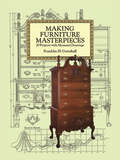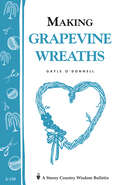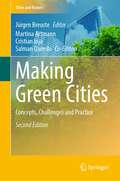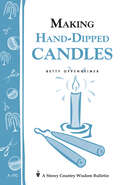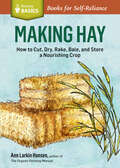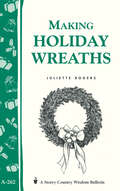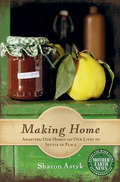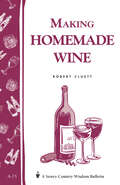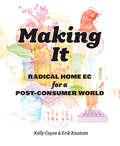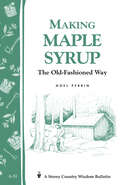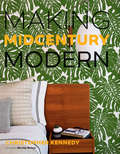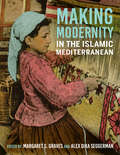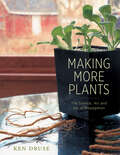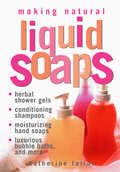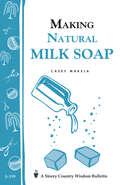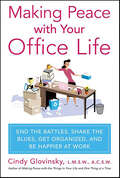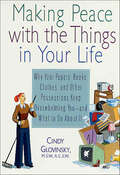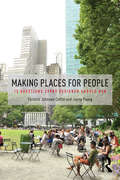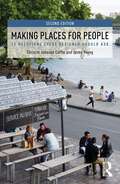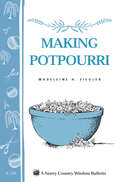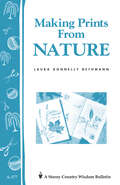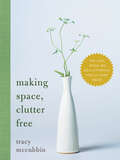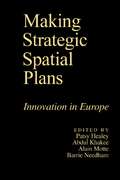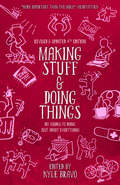- Table View
- List View
Making Furniture Masterpieces: 30 Projects with Measured Drawings
by Franklin H. GottshallThis clearly written how-to book by master craftsman Franklin H. Gottshall allows woodworkers to construct handsome, useful furniture in the most highly regarded antique styles. Characterized by beauty and richness of design, each of 30 different projects -- all replicas of actual rare furniture -- can be completed by ambitious beginners as well as skilled crafters for only a fraction of what vintage originals would cost.Woodcrafters can choose from pieces spanning a wide variety of styles -- from a simple dovetailed box to an elegant Philadelphia Chippendale highboy. Included as well are directions for constructing a Dutch cupboard, refectory table, gateleg table, shelf top corner cupboard, Queen Anne hall table, Pennsylvania Dutch painted chest, and other distinctive pieces.Easy-to-follow, step-by-step instructions are accompanied by photographs and drawings as well as front and end views and detailed sketches of parts and procedures. Decorative skills such as woodcarving, upholstering, finishing, and wrought-iron work are also fully described and related for each piece.
Making Grapevine Wreaths: Storey's Country Wisdom Bulletin A-150
by Gayle O'DonnellSince 1973, Storey's Country Wisdom Bulletins have offered practical, hands-on instructions designed to help readers master dozens of country living skills quickly and easily. There are now more than 170 titles in this series, and their remarkable popularity reflects the common desire of country and city dwellers alike to cultivate personal independence in everyday life.
Making Green Cities: Concepts, Challenges and Practice (Cities and Nature)
by Jürgen Breuste Martina Artmann Cristian Ioja Salman QureshiThis book shows what role nature can play in a city and how this can make it a better place for people to live. People, planners, designers and politicians are working towards the development of green cities. Some cities are already promoted as green cities, while others are on their way to become one. But their goals are often unclear and can include different facets. Presenting contributions from world leading researchers in the field of urban ecology, the editors provide an interdisciplinary overview of best practices and challenges in creating green cities. They show examples of how to build up these cities from bits and pieces to districts and urban extensions. Each example concludes with a summary of the collected knowledge, the learning points and how this can be used in other places. The best practices are collected from around the world – Europe, America and Asia. Contributions cover a wide range of biophysical and cultural backgrounds within these three continents, including the Central, Southern and Eastern European region, as well as Latin and North America. The new dynamic urban development of Asia is illustrated by case studies from China and the Indian subcontinent. The reader will learn which role nature can play in green cities and what the basic requirements are in terms of culture, pre-existing nature conditions, existing urban surroundings, history, design and planning.
Making Hand-Dipped Candles: Storey's Country Wisdom Bulletin A-192 (Storey Country Wisdom Bulletin Ser.)
by Betty OppenheimerSince 1973, Storey's Country Wisdom Bulletins have offered practical, hands-on instructions designed to help readers master dozens of country living skills quickly and easily. There are now more than 170 titles in this series, and their remarkable popularity reflects the common desire of country and city dwellers alike to cultivate personal independence in everyday life.
Making Hay: How to Cut, Dry, Rake, Gather, and Store a Nourishing Crop. A Storey BASICS® Title (Storey Basics)
by Ann Larkin HansenAnn Larkin Hansen offers expert advice on everything from scythes to disc mowers, and details the pros and cons of using horse power or tractors. You’ll learn how to choose the right species for your soil, judge hay quality to buy or sell, and determine how many bales your animals need to stay happy, healthy, and energetic.
Making Holiday Wreaths: Storey's Country Wisdom Bulletin A-262 (Storey Country Wisdom Bulletin Ser.)
by Juliette RogersWhether you want to create a beautiful wreath from scratch or quickly adorn a pre-made wreath base, you'll find all the instruction you need in Making Holiday Wreaths. Learn how to make a boxwood wreath entwined with holly and ivy to grace the front door. Craft balsam wreaths to fill your home with the sweet scent of the forest. Hang gaily decorated wreaths from doors, windows, and mirror frames, or display them on mantels and tabletops. And don't limit your holiday cheer to the house - wrap an evergreen garland around the post of your mailbox, craft a wreath to encircle your birdbath, or clip a row of whimsical wreaths along your clothesline. You can even put out a wreath filled with delectable tidbits to delight your backyard birds!
Making Home: Adapting Our Homes and Our Lives to Settle in Place (Mother Earth News Books for Wiser Living)
by Sharon Astyk&“Shows us why the actions that prepare us for emergencies and energy descent are the right things to do no matter what the future brings.&” —Toby Hemenway, author of Gaia&’s Garden Other books tell us how to live the good life—but you might have to win the lottery to do it. Making Home is about improving life with the real people around us and the resources we already have. While encouraging us to be more resilient in the face of hard times, author Sharon Astyk also points out the beauty, grace, and elegance that result, because getting the most out of everything we use is a way of transforming our lives into something much more fulfilling. Written from the perspective of a family who has already made this transition, Making Home shows readers how to turn the challenge of living with less into settling for more—more happiness, more security, and more peace of mind. Learn simple but effective strategies to: · Save money on everything from heating and cooling to refrigeration, laundry, water, sanitation, cooking, and cleaning · Create a stronger, more resilient family · Preserve more for future generations We must make fundamental changes to our way of life in the face of ongoing economic crisis and energy depletion. Making Home takes the fear out of this prospect, and invites us to embrace a simpler, more abundant reality. &“Americans are born to be transient—Sharon Astyk has the prescription for dealing with that genetic disease, and building a healthy nativeness into our lives.&” —Bill McKibben, New York Times–bestselling author &“Exhaustively researched and compassionately delivered.&” —Harriet Fasenfest, author of A Householder&’s Guide to the Universe
Making Homemade Wine: Storey's Country Wisdom Bulletin A-75
by Robert CluettWant to impress your friends? Serve up some outstanding wine with dinner--and then tell them it's homemade! In Making Homemade Wine, author Robert Cluett takes the mystery out of winemaking. Using his simple nine-step process, you'll learn how to make superb-tasting wines right in your own home. Whether you want to make a common or unusual wine--from everything from grapes to elderberries to parsnips--you'll find the recipes and know-how here. There's even a universal wine formula that allows you to create your own unique recipes! And if your wine doesn't turn out as you expected, never fear--you can read up on Cluett's tips for preventing and fixing the most common problems home winemakers encounter.
Making It: Radical Home Ec for a Post-Consumer World
by Kelly Coyne Erik KnutzenSpending money is the last thing anyone wants to do right now. We are in the midst of a massive cultural shift away from consumerism and toward a vibrant and very active countermovement that has been thriving on the outskirts for quite some time—do-it-yourselfers who make frugal, homemade living hip are challenging the notion that true wealth has anything to do with money. In Making It, Coyne and Knutzen, who are at the forefront of this movement, provide readers with all the tools they need for this radical shift in home economics.The projects range from simple to ambitious and include activities done in the home, in the garden, and out in the streets. With step-by-step instructions for a wide range of projects—from growing food in an apartment and building a ninety-nine-cent solar oven to creating safe, effective laundry soap for pennies a gallon and fishing in urban waterways—Making It will be the go-to source for post-consumer living activities that are fun, inexpensive, and eminently doable. Within hours of buying this book, readers will be able to start transitioning into a creative, sustainable mode of living that is not just a temporary fad but a cultural revolution.
Making Maple Syrup: Storey's Country Wisdom Bulletin A-51
by Noel PerrinSince 1973, Storey's Country Wisdom Bulletins have offered practical, hands-on instructions designed to help readers master dozens of country living skills quickly and easily. There are now more than 170 titles in this series, and their remarkable popularity reflects the common desire of country and city dwellers alike to cultivate personal independence in everyday life.
Making Midcentury Modern: Designs For The Home
by Christopher KennedyThe acclaimed interior designer shares one hundred tips for bringing the principles of midcentury modern style to any home in this beautifully photographed volume. With its minimalist elegance and nostalgic warmth, Midcentury modern style continues to capture the American consciousness. We see it everywhere from television shows to fashion runways. Yet, not all of us can live in a pedigreed midcentury home. Now, Springs interior designer Christopher Kennedy demonstrates how the principles of midcentury design can be applied to the most unassuming spaces.Making Midcentury Modern offers one hundred foolproof tips for introducing modernist design into a contemporary home. In line with forward-thinking designers of the midcentury, the simple yet inspiring ideas in this book are presented alongside stunning color photography.
Making Modernity in the Islamic Mediterranean
by Marcus Milwright Peter Christensen Ünver Rüstem Gülru Çakmak Hala Auji Emily Neumeier Jessica Gerschultz Ashley Dimmig David J. RoxburghThe Islamic world's artistic traditions experienced profound transformation in the 19th century as rapidly developing technologies and globalizing markets ushered in drastic changes in technique, style, and content. Despite the importance and ingenuity of these developments, the 19th century remains a gap in the history of Islamic art. To fill this opening in art historical scholarship, Making Modernity in the Islamic Mediterranean charts transformations in image-making, architecture, and craft production in the Islamic world from Fez to Istanbul. Contributors focus on the shifting methods of production, reproduction, circulation, and exchange artists faced as they worked in fields such as photography, weaving, design, metalwork, ceramics, and even transportation. Covering a range of media and a wide geographical spread, Making Modernity in the Islamic Mediterranean reveals how 19th-century artists in the Middle East and North Africa reckoned with new tools, materials, and tastes from local perspectives.
Making More Plants: The Science, Art, and Joy of Propagation
by Ken DruseA guide to propagation from the author of The New Shade Garden, with over 500 photographs: “My bible for rejuvenating plants.” —Anne Raver, The New York TimesFor people who love gardens, propagation—the practice of growing whatever you want, whenever you want—is gardening itself. In Making More Plants, one of America's foremost gardening authorities, presents innovative, practical techniques for expanding any plant collection, along with more than 500 photographs. Based on years of research, this is a practical manual as well as a beautiful garden book, presenting procedures Ken Druse has personally tested and adapted, as well as photographed step by step.“This is a book for all seasons, and will appeal to anyone intrigued by how plants grow.” —Virginia McClain Miller, Fine Gardening
Making Natural Liquid Soaps: Herbal Shower Gels, Conditioning Shampoos, Moisturizing Hand Soaps, Luxurious Bubble Baths, and more
by Catherine FailorMake our own liquid soaps and body products right in your kitchen. Catherine Failor shows you how to use her simple double-boiler technique to create luxurious shower gels, revitalizing shampoos, energizing body scrubs, and much more. Step-by-step instructions teach you how to turn basic ingredients like cocoa butter, lanolin, and jojoba into sweet-smelling liquid soaps. You’ll soon be experimenting with your favorite oils and additives as you craft custom-made products that are kind to your nose and gentle on your skin.
Making Natural Milk Soap: Storey's Country Wisdom Bulletin A-199
by Casey MakelaSince 1973, Storey's Country Wisdom Bulletins have offered practical, hands-on instructions designed to help readers master dozens of country living skills quickly and easily. There are now more than 170 titles in this series, and their remarkable popularity reflects the common desire of country and city dwellers alike to cultivate personal independence in everyday life.
Making Peace with Your Office Life: End the Battles, Shake the Blues, Get Organized, and Be Happier at Work
by Cindy GlovinskyDo you feel disconnected and disorganized on the job?Do you feel powerless in the face of multiple office challenges, from organizing your desk to dealing with office bullies?Are you sick of it all and ready to be happy at work?Help is on the way! Cindy Glovinsky, licensed psychotherapist and expert on organizing and mental health, is uniquely qualified to offer solutions to your office blues, including:- Dozens of anecdotes and insightful exercises- Simple, effective organizing tips- Hundreds of easy ways to connect with colleagues- Great ways to make positive changes in the workplaceWhether you dread coming to work every day or you're just looking for a new way to deal with office issues, MAKING PEACE WITH YOUR OFFICE LIFE offers a fresh, liberating view of the office world and practical ways to cope with its day-to-day challenges.
Making Peace with the Things in Your Life: Why Your Papers, Books, Clothes, and Other Possessions Keep Overwhelming You—and What to Do About It
by Cindy GlovinskyA therapist and professional organizer “explains [the] mental glitches that can make organizing harder for some people than others”—and how to fix them (Library Journal).Do you spend a lot of time struggling against the growing ranks of papers, books, clothes, housewares, mementos, and other possessions that seem to multiply when you’re not looking? Help is on the way. Cindy Glovinsky, practicing psychotherapist and personal organizer, is uniquely qualified to explain this nagging, even debilitating problem—and to provide solutions that really work.With a supportive, nonjudgmental tone, Glovinsky uses humorous examples, questionnaires, and exercises to shed light on the real reasons why we feel so overwhelmed by papers and possessions and offers individualized suggestions tailored to specific organizing problems. Whether you’re drowning in clutter or just looking for a new way to deal with the perennial challenge of organizing and managing material things, this fresh and reassuring approach is sure to ease the stress.
Making People-Friendly Towns: Improving the Public Environment in Towns and Cities
by Francis TibbaldsMaking People-Friendly Towns explores the way our towns and cities, particularly their central areas, look and feel to all their users and discusses their design, maintenance and management. Francis Tibbalds provides a new philosophical approach to the problem, suggesting that places as a whole matter much more than the individual components that make up the urban environment such as buildings, roads and parks. This informative book suggests the way forward for professionals, decision-makers and all those who care about the future of our urban environment and points the reader in the direction of a wealth of living examples of successful town planning.
Making Places for People: 12 Questions Every Designer Should Ask
by Jenny Young Christie Johnson Coffin** Honorable Mention at the 2019 ERDA Great Places Awards ** Making Places for People explores twelve social questions in environmental design. Authors Christie Johnson Coffin and Jenny Young bring perspectives from practice and teaching to challenge assumptions about how places meet human needs. The book reveals deeper complexities in addressing basic questions, such as: What is the story of this place? What logic orders it? How big is it? How sustainable is it? Providing an overview of a growing body of knowledge about people and places, Making Places for People stimulates curiosity and further discussion. The authors argue that critical understanding of the relationships between people and their built environments can inspire designs that better contribute to health, human performance, and social equity—bringing meaning and delight to people’s lives.
Making Places for People: 12 Questions Every Designer Should Ask
by Jenny Young Christie Johnson CoffinMaking Places for People explores 12 social questions crucial to environmental design. Authors Christie Johnson Coffin and Jenny Young bring perspectives from practice and teaching to challenge assumptions about how places meet human needs. In this expanded second edition, the authors continue to explore the complexities of basic questions, such as: What is the story of this place? What logic orders it? How big is it? How sustainable is it? They consider the impact on making places of pandemic, climate change, human migration, and contemporary discussions of diversity, equity, and justice. Short, approachable, easy-to-read chapters, illustrated with updated examples of projects from around the world, bring together theory, methodology and key research findings. Understanding experienced and research-based connections between people and built form can inspire designs that make places of meaning and delight. This second edition will be essential reading for design students and professionals.
Making Potpourri: Storey's Country Wisdom Bulletin A-130 (Storey Country Wisdom Bulletin Ser.)
by Madeleine H. SieglerSince 1973, Storey's Country Wisdom Bulletins have offered practical, hands-on instructions designed to help readers master dozens of country living skills quickly and easily. There are now more than 170 titles in this series, and their remarkable popularity reflects the common desire of country and city dwellers alike to cultivate personal independence in everyday life.
Making Prints from Nature: Storey's Country Wisdom Bulletin A-177
by Laura Donnelly BethmannSince 1973, Storey's Country Wisdom Bulletins have offered practical, hands-on instructions designed to help readers master dozens of country living skills quickly and easily. There are now more than 170 titles in this series, and their remarkable popularity reflects the common desire of country and city dwellers alike to cultivate personal independence in everyday life.
Making Space, Clutter Free: The Last Book on Decluttering You'll Ever Need
by Tracy McCubbin"This isn't another Kondo-clone, because she dives into the heart of why decluttering is so difficult."— Booklist, STARRED ReviewDiscover the freedom of a beautiful home, personal purpose, and joyful inner confidence with the last home organization book you'll ever need.Learn how to declutter your home with expert Tracy McCubbin, who gets to the root of the problem and offers revolutionary help to anyone who has repeatedly tried to break their clutter's mysterious hold and achieve a clutter-free, minimalist home. Her powerful answer lies in the 7 Emotional Clutter Blocks, unconscious obstacles that stand between thousands of her clients and financial freedom, healthy relationships, and positive outlooks.Once a Clutter Block is revealed—and healed—true transformation of home and life is possible. Her empowering techniques and strategies help you:Recognize and overcome your Clutter Block(s) to liberate your home.Learn the tricks of the trade for when the going gets tough.Lighten and purge without the rigidity of other methods.Use your home to attain life goals like health, wealth and love.Declutter after a big life change like a death or divorce.It's time to break through your Clutter Blocks and discover the lasting happiness waiting for you on the other side with the only book on decluttering you need!Additional Praise for Making Space, Clutter Free: "What sets Tracy McCubbin apart is her kind and empathetic approach to organizing—she truly understands the psychology behind peoples' attachment to things."—Patricia Heaton"In Making Space, Clutter Free Tracy offers a realistic approach to managing your belongings. Instead of prescribing perfection, she understands our individual differences require individual strategies—and that it doesn't always need to be rational."—Cait Flanders, bestselling author of The Year of Less
Making Strategic Spatial Plans
by Barrie Needham Patsy Healey Abdul Khakee Alain MotteA pan-European survey of strategic planning issues in response to technological innovation and its spatial consequences, this text should interest all planners, geographers and others concerned wtih the planning and management of economic development.
Making Stuff and Doing Things: DIY Guides to Just About Everything
by Kyle BravoWhen you're young, broke, and in search of a life of adventure, Making Stuff and Doing Things is the most useful book on the planet. It's been called "more important than the Bible." It's an indispensable handbook full of basic life skills for the young punk or activist, or for anyone who's trying to get by, get stuff done, and live life to the fullest without a lot of money. The book started in the 90s as a series of zines, with dozens of contributors setting down the most important skills they knew in concise, often hand-written pages. If you want to do it yourself or do it together, this book has it all, from making your own tooth paste to making your own art and media, feeding, clothing, cleaning, and entertaining yourself, surviving on little, living on less, and staying healthy on all your life's adventures. You'll never be bored again.
